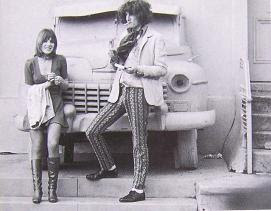
Granny Takes a Trip was an iconic boutique opened in the 1960's in the Kings Road, London, by Nigel Waymouth and Sheila Cohen. The shop brought a radical, iconoclastic approach to the fashion and style of the time. With an ambience that was a mixture of New Orleans bordello and futuristic fantasy, one would experience a heady feeling of deja vu within its walls, an ambience at once retro and au courant. Marbled patterns papered the walls, providing an exotic backdrop to the rails, which always carried an assortment of brightly coloured clothes. Lace curtains draped the doorway of the only changing room, and a beaded glass curtain hung over the entrance at the top of steps, which led on into the shop. In the back room, an art deco Wurlitzer blasted out a selection of favoured music. The shop also became famous for its constantly changing facade. At one time the entire front was painted with a giant pop-art face of Jean Harlow. Overnight, that was replaced by an actual 1948 Dodge saloon car which appeared to crash out from the window and onto the forecourt. Over the next three years contrasting changes such as this took place at regular intervals. By the end of the decade, the partnership began to lose momentum. Nigel Waymouth was becoming increasingly more involved in his poster and album cover design work, and John Pearse left for Italy to work with his friends in The Living Theatre Group. Sheila Cohen continued to keep Granny operating but found it too demanding a task without her former partners. In late 1969, Cohen passed on the shop to two New Yorkers, Gene Krell and his partner, Marty. Granny Takes A Trip remained open for another four years, until it closed in 1973.





(images from Boutique: A Cultural Phenonmenon)





































%2520Paul%2520Ferrara.jpg)





